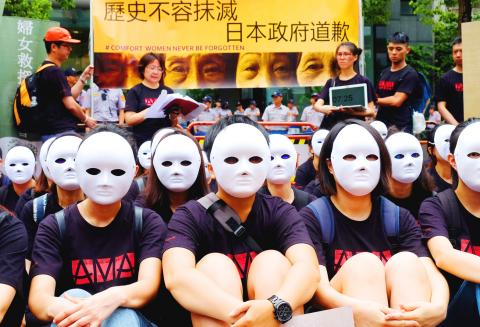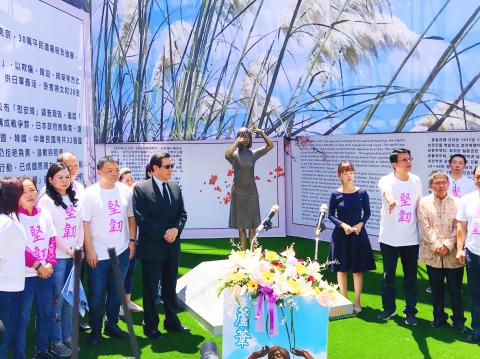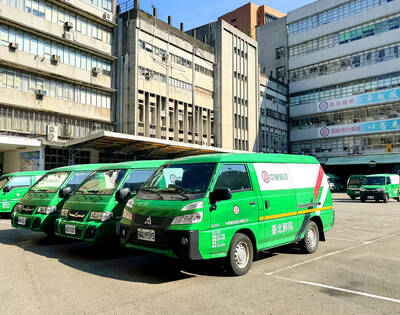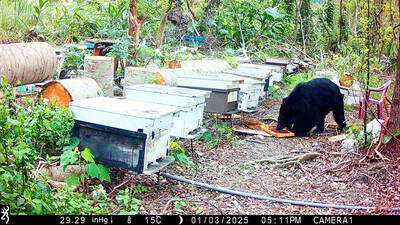About 100 protesters from a coalition of non-governmental organizations yesterday protested outside the Japan-Taiwan Exchange Association in Taipei, demanding that the Japanese government apologize again to surviving Taiwanese “comfort women” and provide them with compensation.
About 2,000 Taiwanese women were estimated to have been forced into sexual slavery by the Imperial Japanese Army during World War II, and the Taipei Women’s Rescue Foundation located 59 survivors after it set up a hotline in 1992, foundation chief executive Fan Ching (范情) said.
“Only two of them remain today and neither were able to attend this demonstration because of their advanced age,” she said.

Photo: Sam Yeh, AFP
Instead, 59 people clad in black and wearing white masks sat silently next to a paper wall printed with the names of the comfort women they represented.
As in its previous protests, the foundation demanded that Japan’s prime minister apologize to the former comfort women on behalf of the Japanese government and provide them compensation.
It also urged the Japanese government to release all documents related to comfort women, initiate an investigation into their history and educate the public about sexual slavery.

Photo: CNA
“To better protect women’s rights and prevent similar things from happening again, the history must be included in Japanese textbooks,” Fan said, adding that until a Japanese prime minister apologizes, the foundation would its annual protests.
The Japanese government should build a museum commemorating the history of comfort women in Japan to educate the public about it, foundation chairwoman Huang Shu-ling (黃淑玲) said.
The foundation has repeatedly invited Japanese Prime Minister Shinzo Abe to visit the AMA Museum in Taipei’s Datong District (大同), which it founded in 2016 to document the history of the comfort women, she said.
No Japanese official has ever visited it, but many Japanese tourists and journalists have, she said.
“Do not underestimate the power of this movement for comfort women. It is the power of women in Asia and around the world who are standing in solidarity to demand human rights,” Huang said.
Over the past several decades, campaigns calling for justice for comfort women have evolved from a local movement to a global one, with the ultimate goal being to end sexual violence, she said.
“Although survivors age and pass away, the movement will not die, because their influence will continue to grow as more young people join in, bringing with them new momentum,” she said.
In Tainan, the Chinese Nationalist Party’s (KMT) Tainan chapter and the Tainan Association for Comfort Women’s Rights yesterday unveiled the nation’s first bronze statue of a comfort woman
At the ceremony, former president Ma Ying-jeou (馬英九) urged the Japanese government to formerly apologize to Taiwanese comfort women and provide compensation.
Aug. 14 has become a day to remember comfort women in Taiwan and South Korea because on Aug. 14, 1991, South Korean Kim Hak-sun became the first former comfort woman to give public testimony about her experience.
Additional reporting by Wang Chun-chung

SHIPS, TRAINS AND AUTOMOBILES: The ministry has announced changes to varied transportation industries taking effect soon, with a number of effects for passengers Beginning next month, the post office is canceling signature upon delivery and written inquiry services for international registered small packets in accordance with the new policy of the Universal Postal Union, the Ministry of Transportation and Communications said yesterday. The new policy does not apply to packets that are to be delivered to China, the ministry said. Senders of international registered small packets would receive a NT$10 rebate on postage if the packets are sent from Jan. 1 to March 31, it added. The ministry said that three other policies are also scheduled to take effect next month. International cruise ship operators

HORROR STORIES: One victim recounted not realizing they had been stabbed and seeing people bleeding, while another recalled breaking down in tears after fleeing A man on Friday died after he tried to fight the knife-wielding suspect who went on a stabbing spree near two of Taipei’s busiest metro stations, Taipei Mayor Chiang Wan-an (蔣萬安) said. The 57-year-old man, identified by his family name, Yu (余), encountered the suspect at Exit M7 of Taipei Main Station and immediately tried to stop him, but was fatally wounded and later died, Chiang said, calling the incident “heartbreaking.” Yu’s family would receive at least NT$5 million (US$158,584) in compensation through the Taipei Rapid Transit Corp’s (TRTC) insurance coverage, he said after convening an emergency security response meeting yesterday morning. National

The Forestry and Nature Conservation Agency yesterday launched a gift box to market honey “certified by a Formosan black bear” in appreciation of a beekeeper’s amicable interaction with a honey-thieving bear. Beekeeper Chih Ming-chen (池明鎮) in January inspected his bee farm in Hualien County’s Jhuosi Township (卓溪) and found that more than 20 beehives had been destroyed and many hives were eaten, with bear droppings and paw prints near the destroyed hives, the agency said. Chih returned to the farm to move the remaining beehives away that evening when he encountered a Formosan black bear only 20m away, the agency said. The bear

PLANNED: The suspect visited the crime scene before the killings, seeking information on how to access the roof, and had extensively researched a 2014 stabbing incident The suspect in a stabbing attack that killed three people and injured 11 in Taipei on Friday had planned the assault and set fires at other locations earlier in the day, law enforcement officials said yesterday. National Police Agency (NPA) Director-General Chang Jung-hsin (張榮興) said the suspect, a 27-year-old man named Chang Wen (張文), began the attacks at 3:40pm, first setting off smoke bombs on a road, damaging cars and motorbikes. Earlier, Chang Wen set fire to a rental room where he was staying on Gongyuan Road in Zhongzheng District (中正), Chang Jung-hsin said. The suspect later threw smoke grenades near two exits